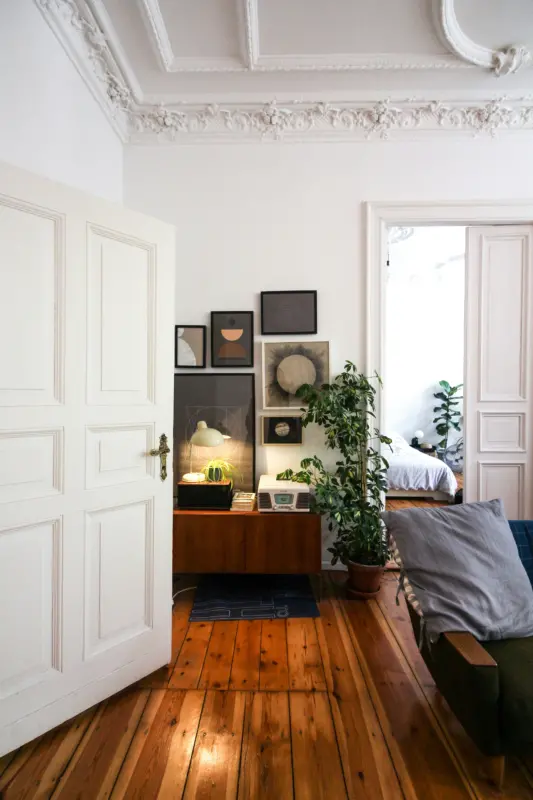A bathroom is a room with a unique microclimate, and therefore, deciding to replace the door slab (or equip a bathroom in a new building with a door), buying the first one that you like by design or fits the rest of the doors of the house – it will be highly reckless and unreasonable.

The humidity level in the room where we perform hygiene procedures is perhaps the highest compared to the rest of the rooms in the house. This means that not every material can withstand constant exposure to moisture and steam temperature changes. Our article will tell you about the most popular materials used in the manufacture of interior doors, and, of course, you will find out which one will be the most acceptable in the bathroom.
Materials for the manufacture of bathroom doors
Products are covered with PVC film. The bathroom door slab itself is usually made of MDF, less often – of wood, and the coating, in fact, of a particular film. It protects the “insides” of the slabs from moisture and steam. These doors are a good option for the bathroom. Their cost is small, and the film can be of any color and texture, which allows you to choose a product that fits perfectly into the interior. But, like any model, PVC doors also have their drawbacks – the slabs can delaminate, after which moisture begins to get inside, and the door gradually becomes unusable.
Laminated doors. They have the lowest price among products that fit into the bathroom. Paper is glued to the base of the door, which is coated with special resins. If this coating is of high quality, then the moisture of such a door will not be terrible. And if the manufacturer saves, the layer can quickly be damaged, and water will get inside the door. The slabs will swell and will no longer be able to open and close normally.
Eco veneer. It is plastic, but only more modernized, with the addition of wood fibers. And all this is fastened with a special plastic compound, which is not harmful to health. Such doors are ideal for the bathroom: they are beautiful because they imitate the wood structure, and most importantly, they are not afraid of moisture, steam, and temperature changes.
Traditional veneer. This coating is without plastic, only from wood fibers. Although covered with a special protective varnish on top, such doors are still susceptible to moisture. If you have a large bathroom, and the bath or shower itself is far from the door, then, in principle, such a model can be installed. If the room is small and the door is exposed to moisture and steam, we do not recommend its installation.
Glass doors. The option, without exaggeration, is ideal. Glass is not afraid of moisture and other bathroom effects. In addition, they are environmentally friendly and look pretty elegant. Among the disadvantages of such products are a considerable price and the possibility of damage (although they are tough to break, still, there is such a possibility).
Wooden doors. The most environmentally friendly option. Doors made of wood look solid. They will be appropriate in many interiors. But, they also do not like moisture. Of course, wooden doors are covered with special impregnations and varnish, but if you do not want such a product to be saturated with water over time, the coating will have to be updated regularly.
Doors are made of chipboard and MDF without any coatings. Such models will be suitable for installation between living rooms but not in the bathroom. They are not designed for use in rooms where the humidity is above standard. After saturating themselves with water, they will swell and eventually become unusable.
You know which bathroom product will be the most acceptable option for you, both in price and quality. The main thing to remember is not to save too much on such a product. Otherwise, you will have to change the door to the bathroom very soon.

 All Interior Doors
All Interior Doors Prehung Doors
Prehung Doors Doors By Style
Doors By Style Doors By Room
Doors By Room Sliding Doors
Sliding Doors Doors By Color
Doors By Color Bi-Fold Doors
Bi-Fold Doors French Interior Doors
French Interior Doors All Exterior Doors
All Exterior Doors Steel Security Doors
Steel Security Doors Fiberglass Doors
Fiberglass Doors Wrought Iron Doors
Wrought Iron Doors Aluminum Windows
Aluminum Windows Vinyl Windows
Vinyl Windows Wood Windows
Wood Windows Tables
Tables Accessories
Accessories Magic Door Hardware
Magic Door Hardware Magnetic Door Hardware
Magnetic Door Hardware Entry Handle sets
Entry Handle sets Barn Door Hardware
Barn Door Hardware Pocket Door Hardware
Pocket Door Hardware Door Levers
Door Levers Magnetic Locks
Magnetic Locks Hinges
Hinges Bathroom Mirrors
Bathroom Mirrors Wall-Mounted Vanities
Wall-Mounted Vanities
















 Steel Security Doors
Steel Security Doors